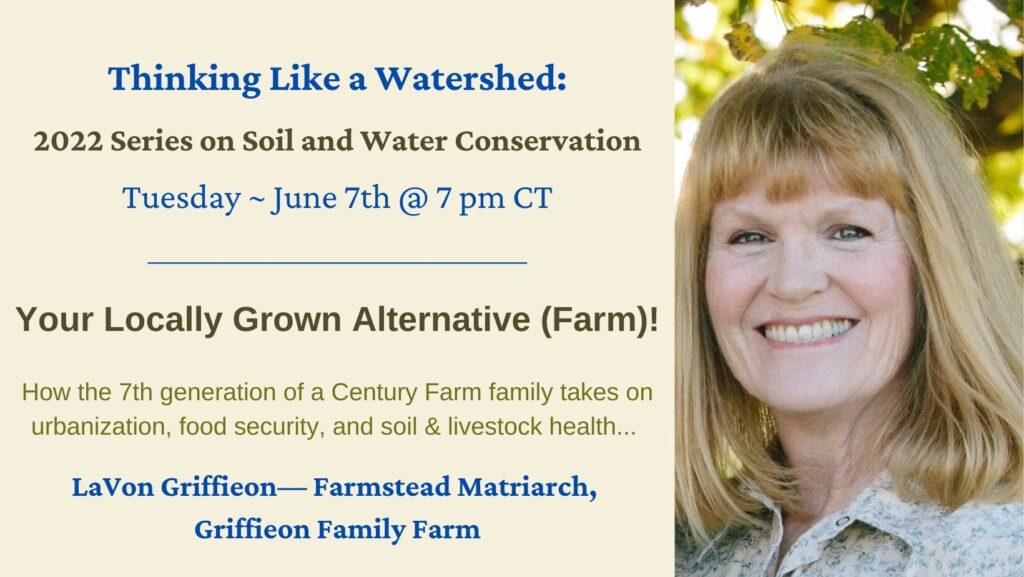But first!
Top of page for deadlines, with details below. Read on for how to act on your priorities:
➢ June 7 at 7 p.m. Central, our Upper Mississippi River Initiative (UMRI) monthly virtual series, “Thinking Like a Watershed” with the Griffieon family matriarch on farming sustainably with urban growth. Registration required.
➢ June 15 at 6:30 p.m. – Minnesota Water Congress convenes in person in Mankato. Gov. Walz speaks at 7 p.m. and you are invited. It’s free.
➢ Spring stream monitoring is underway in the Driftless. Want to join in?
“Your Locally Grown Alternative (Farm!)”
Register in advance for another extraordinary presentation— Our monthly “Thinking Like a Watershed” program ends the season on Tuesday, June 7, 2022, at 7 p.m. Central with a conversation with LaVon Griffieon on, “How the seventh generation of a century farm family takes on urbanization, food security, and soil and livestock health.”
After registering, you will receive a confirmation email with the link to join the program on Tuesday, June 7th, 2022, starting at 7 p.m. Central.
This monthly series is a project of the Upper Mississippi River Initiative (UMRI) of the Izaak Walton League of America, with co-hosts Chris Henning of the Panora Conservation Chapter and Des Moines Chapter Communication Director, Bud Hartley. We feature guests for 30-40 minute presentations that shed daylight on good works done in the name of the Mississippi and its uplands. In this way we uplift our shared goals for a cleaner river, a cared for environment, and kinder communities. Recorded programs are available shortly after they air live. (Links to all past programs are at the end of this page.).
Minnesota Water Congress invitation
The Minnesota Water Congress gathers in person at last in Mankato, MN on June 15 with keynote presentations that include an electronic address by Gov. Tim Walz at 7 p.m. The event, like the organization, is open to the public starting at 6:30 p.m. No RSVP is required. This body is all about improving water storage and as such, the UMRI team that leads the investigations into ditch projects in the MN River Watershed will be present as co-host. The website for the Congress itself is here. https://www.mnrivercongress.org/network The press release for the event follows:
Contacts:
Scott Sparlin 507 276 2280
Dave Zentner 218 724 3926
David Minge 651 493 9488
Ted Suss 507 828 3377
The Minnesota River Congress will be holding its 14th full session on Wednesday, June 15th, 2022, at the Kato Ballroom, 200 Chestnut St. Mankato MN. This will mark the first in-person full meeting since the pandemic initial outbreak. The public is invited and welcome to participate. Doors open at 6:30 PM.
The Minnesota River Congress’s mission is: “To promote citizen participation from all communities of interest and take cooperative action to protect, conserve and improve the Minnesota River System”.
A background on past and present actions and activities informing participants as to where things are at right now will open the meeting. Our co-hosts the Izaak Walton League’s Upper Mississippi River Initiative will be part of the update.
Governor Tim Walz will address the group electronically starting at 7 PM. Minnesota Department of Natural Resources Commissioner, Sarah Strommen; Board of Water and Soil Resources Executive Director, John Jaschke; and Chief Engineer, Rita Weaver, will be in attendance to speak regarding the many faces of water storage and what it means to everyone. Other state agency heads have been invited to speak as well. All public participants will have the opportunity to give direction and input to the Minnesota River Congress Action Board on moving their Water Storage Initiative forward.
Minnesota River Congress participants have been working diligently since the pandemic addressing our priority issue as voted on May 17th, 2018, and again at our last active in person session. Our Water Storage Initiative support has grown significantly. Together with our numerous partners, supporters, and elected officials from both parties, we were successful at establishing a program that will address water storage in our Minnesota basin and the Mississippi River Basin downstream from the Metro to the state border. The program is currently in its demonstration phase and is accepting proposals. It is currently funded at 1 million dollars each for the next two years. This is a great first step and establishes the program in statute, however, that amount of resources won’t go very far in realistically addressing the scope of the need.
What is needed now is the kind of resources that will establish all forms of water storage throughout the entire watershed. This will require a much larger commitment from the State of Minnesota along with significant federal support as well. We plan to continue to advocate for that support and that is where the public can assist in our collective efforts. There will be an opportunity for input regarding moving forward and we need you to help create those paths.
Springtime in the Driftless
Our Driftless stream teams are well into spring sampling – please contact Caroline van Schaik if you would like to get your hands wet with us. We have a few sites yet to monitor – at Oxbow Park west of Rochester, another near Lanesboro, and one in Chatfield with tentative dates – and you’d be welcome!

Kick nets and tablecloths, wet and soiled from stream sampling, get a hose down and airing before being folded back into the box for the next stream site. Photo by: Caroline van Schaik

Kick nets and tablecloths, wet and soiled from stream sampling, get a hose down and airing before being folded back into the box for the next stream site. Photo by: Caroline van Schaik

Teams use a yellow kick net to round up macroinvertebrates for what many consider the most intriguing aspect of stream monitoring. With the help of children’s paintbrushes and ice cube trays, species are separated out and then counted. The emphasis is on diversity of species rather than number of any one species. Photo by: Caroline van Schaik
Farmers and Their Soil
Early spring found a multi-state group of odd bedfellows (crop farmers, livestock graziers, university and agricultural agents, environmental non-profits, livestock associations, crop associations…) grappling with how best to illustrate the shared possibilities for crop and livestock farmers to address soil health, pocketbooks, and the public costs of erosion. Many farmers are catching on to the concepts and powerful realities of healthy soil. But how to get there? Does a crop farmer have to add livestock? Can a livestock grazier put heifers on a neighbor’s corn stubble or better, on a cover crop over-wintering before corn? Etc!
The work is led by the Midwest Perennial Forage Working Group of Green Lands Blue Waters (https://greenlandsbluewaters.org/midwest-perennial-forage-working-group/), which just published a poster – an infographic by today’s vernacular – on these ideas. It is a forerunner to a large survey, a handful of tell-all financial studies, and a series of field events. The meetings that went into this graphic shed daylight on conundrums, barriers, a few myths, and the language of confusion that can stop even the best-intended people from working together. That everyone is trying is a testimony to need, or at least interest that refuses to dissipate.
For example, while livestock producers automatically think about crops for feed, crop farmers do not think about livestock unless they are interested in improving soil health, as many are. But there are logistical challenges to bringing on livestock compounded by a shortage of livestock advisors. This is a problem. On the solutions side of the ledger is this idea: “Livestock” can mean sheep or over-wintering dairy heifers, for examples, not just beef cows. Alternatively, raising small grains for feed, or planting a cover crop for root health and the manure of a neighbor’s livestock brings some of those livestock benefits onto a crop farm without a crop farmer having to own those animals. The farmer with the animals extends the grazing season and benefits by a later start date to feeding hay.
Take a look and if you want to send this poster around, please, do so. It’s free. You can also contact Caroline van Schaik, UMRI staff and a member of the working group and grant advisory committee.
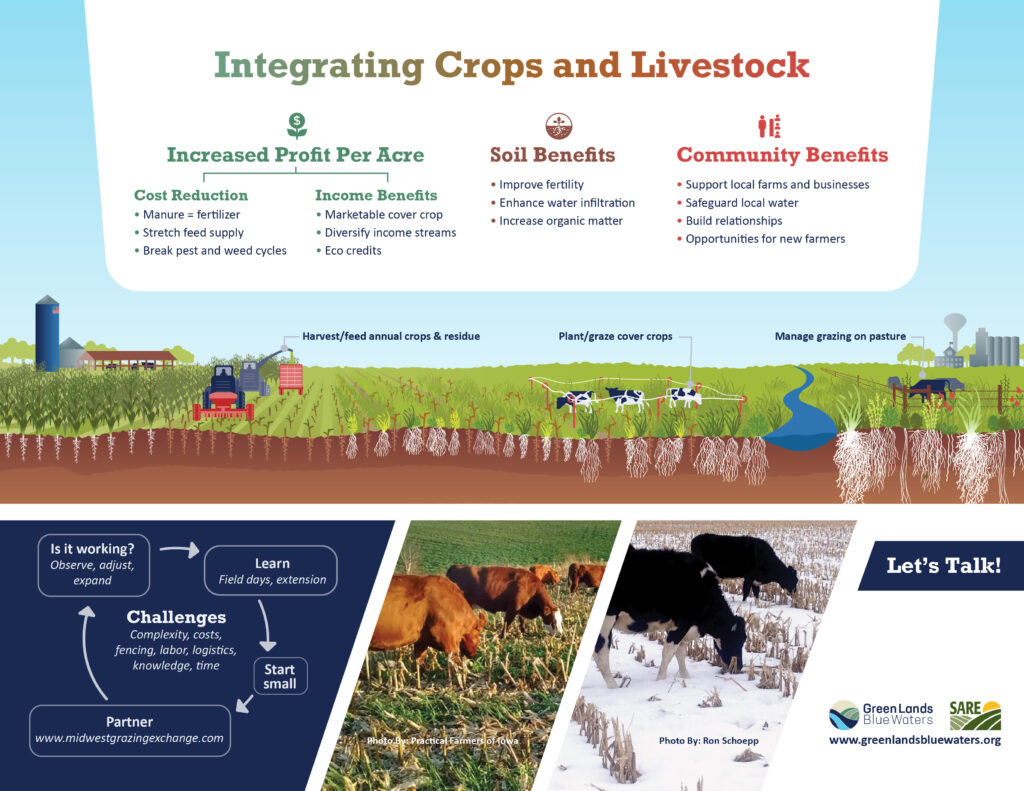
A multi-state group of odd bedfellows arrived at this visual set of suggestions for how crop land and grazing livestock could improve everyone’s soil health and bottom lines. It is free to share; find a higher-resolution version here!
An inter-League of Women Voters presents legislative options
The League of Women Voters-Upper Mississippi River Region interleague organization (LWV UMRR) hosted its annual meeting May 21, 2022 with a discussion of innovative answers to that million dollar question, “Does it take an act of Congress to protect the Mississippi?” The recording has just been posted and can be found here!
The short answer is, yes, Congress is a part of the answer but not the only one. Give a listen to hear innovative ideas and pending legislation that together might bring the Mississippi back from the brink.
Links to recent “Thinking” presentations
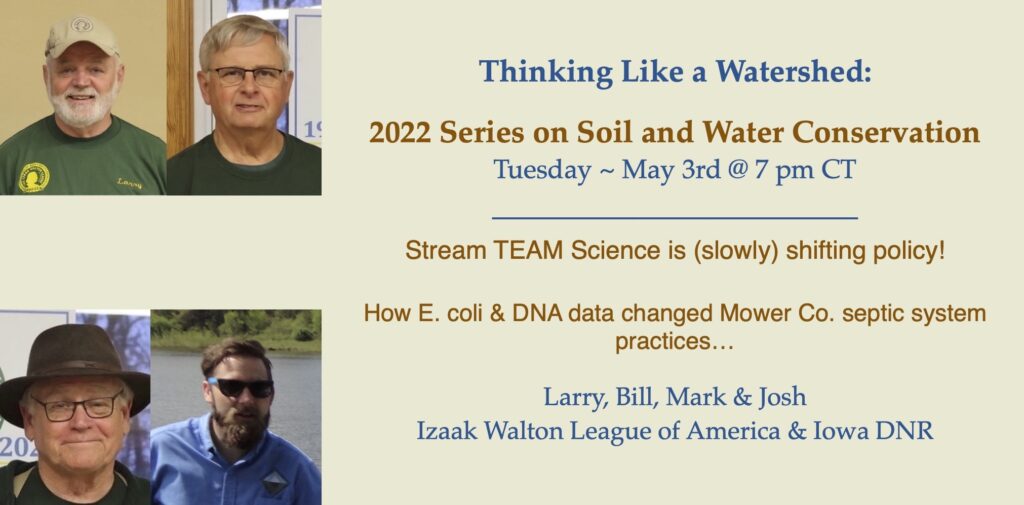
— “Stream TEAM Science is (slowly) shifting policy!” Thinking Like a Watershed ~ Tuesday, May 3, 2022
How E. coli & DNA data changed Mower Co. septic system practices…
A discussion with leaders Larry Dolphin, Bill Buckley, Mark Owens, lifelong members of the Izaak Walton League (IWLA), and Josh Balk, Iowa Department of Natural Resources (DNR)
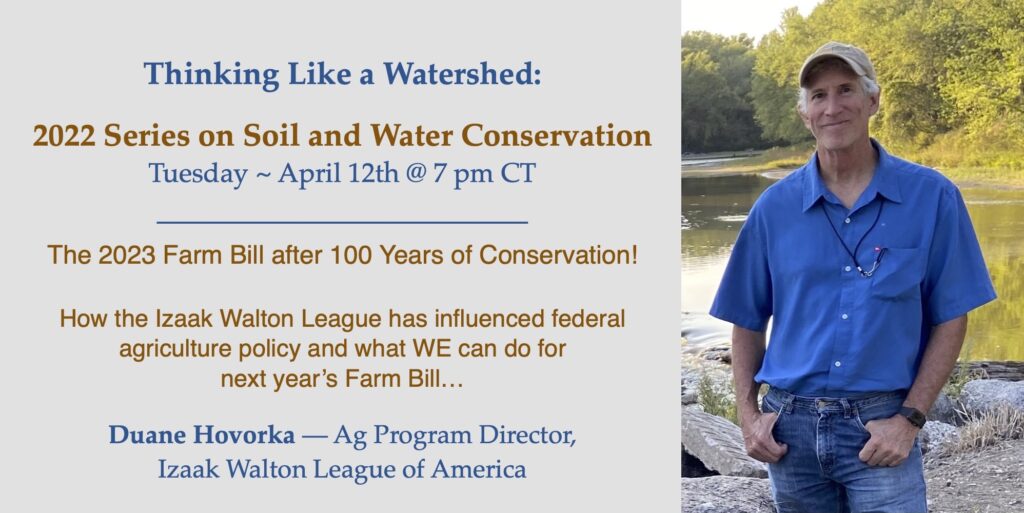
—“The 2023 Farm Bill after 100 Years of Conservation!” Thinking Like a Watershed ~ Duane Hovorka- April 12th, 2022
How the Izaak Walton League has influenced federal agriculture policy and what WE can do for next year’s Farm Bill…with Duane Hovorka, Agriculture Program Director, Izaak Walton League of America
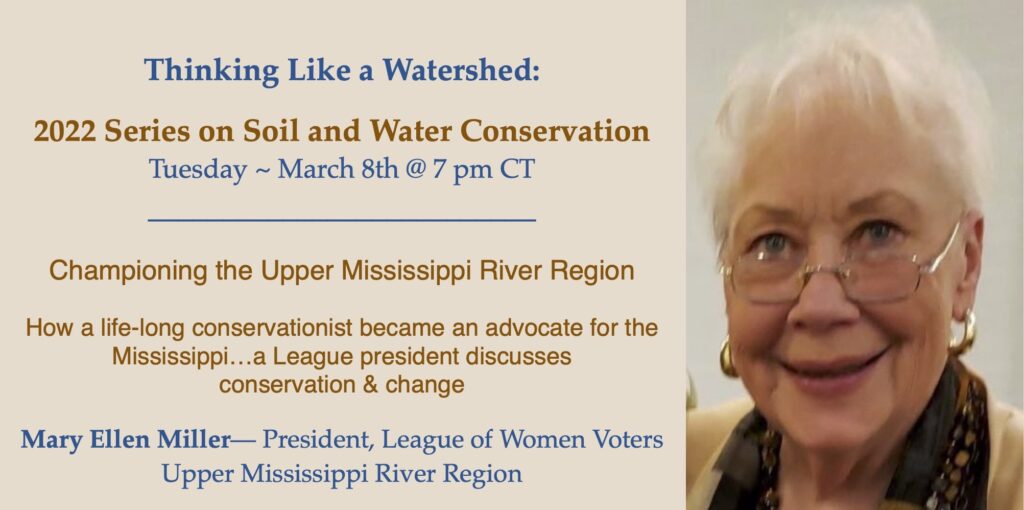
— “Championing the Upper Mississippi River Region” Thinking Like a Watershed ~ Mary Ellen Miller— March 8th, 2022
How a life-long conservationist became an advocate for the Mississippi…a League president discusses conservation & change with Mary Ellen Miller, President, League of Women Voters Upper Mississippi River Region
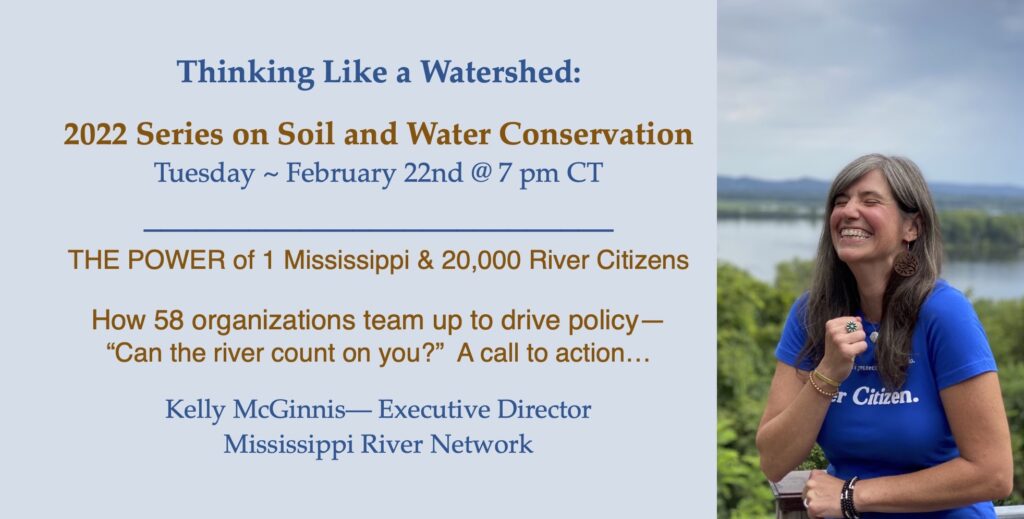
—“The POWER of 1 Mississippi & 20,000 River Citizens” Thinking Like a Watershed ~ Kelly McGinnis— February 22nd, 2022 How 58 organizations team up to drive policy—“Can the river count on you?” A call to action…
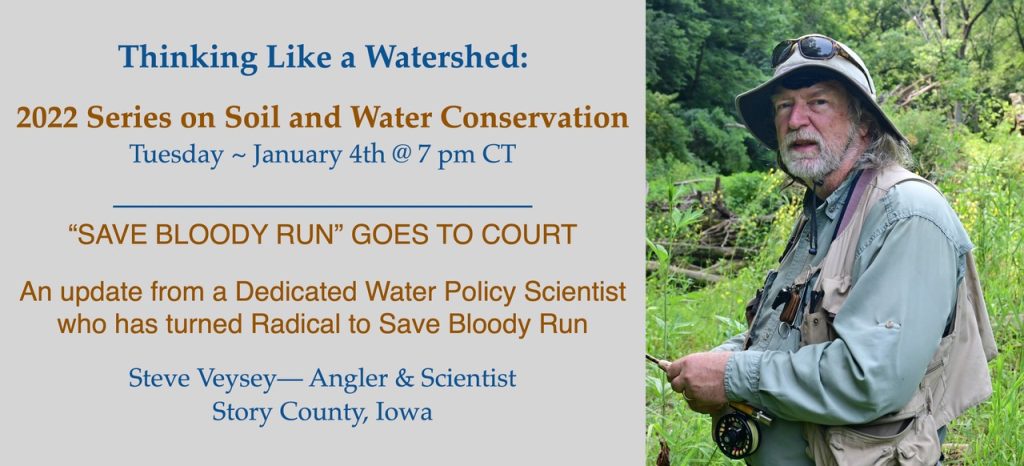
Photo by: David Thoreson
— “Save Bloody Run Goes to Court” Thinking Like a Watershed ~ Steve Veysey— January 4th, 2022 An update from a Dedicated Water Policy Scientist who has turned Radical to Save Bloody Run.
—“Heartland Heroines” Thinking Like a Watershed ~ Robin Moore & Denise O’Brien— June 1, 2021 How two savvy conservationists empower working farm landowners to put their inner land ethic to work.
—“Planting Seeds to Grow Vibrant Communities” Thinking Like a Watershed ~ Chris Deal & Art Cullen— May 4, 2021 How Jefferson, Iowa’s Chris Deal is working with California Rep. Ro Khanna and others to grow vibrant rural communities in the Heartland with perspectives from Pulitzer Prize—winning journalist and editor of The Storm Lake Times, Art Cullen.
—“Watershed Bridges— Green to Blue” Thinking Like a Watershed ~ Vicki Nichols Goldstein & Seth Watkins— April 6, 2021 How improving soil health and water quality in Iowa and other inland states benefit watersheds that provide critical services from land to sea.
—“Local Heroes in Howard County” Thinking Like a Watershed ~ Neil Shaffer & Hunter Slifka— March 2, 2021 How they have incorporated several thousand acres of land under conservation programs–the largest percentage in Iowa.
—“The Accidental Conservationist” Thinking Like a Watershed ~ Wayne Fredericks— February 2, 2021 How an Iowa Farmer is Improving Natural Capital while Increasing Profits with Conservationist and Farmer, Wayne Fredericks from Mitchell County, Iowa.

